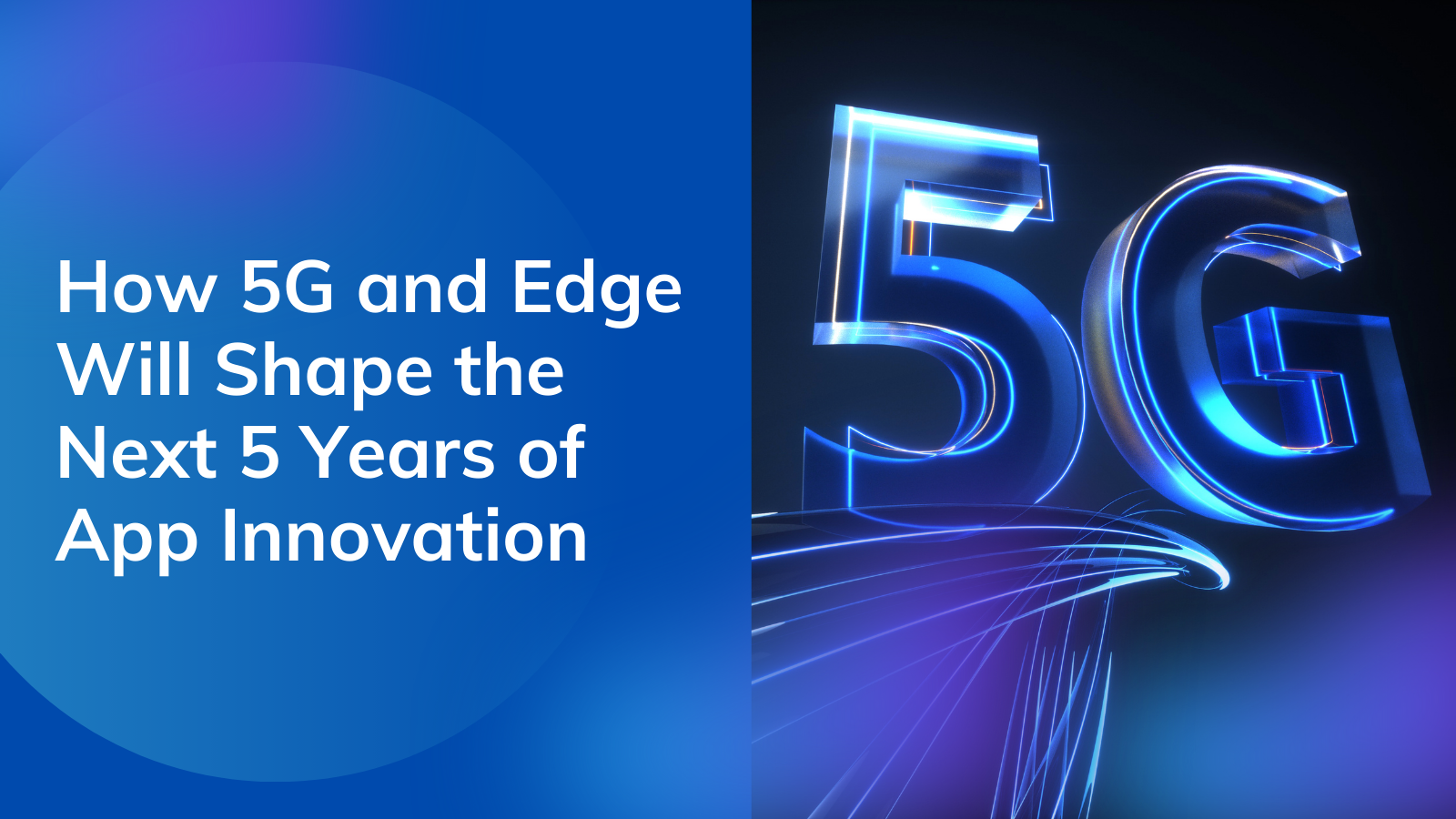May 26, 2025

5G will deliver the ultra-high network speed and dependability needed for the next generation of applications, and edge computing will distribute the computational workload at or very close to the data's source. This decentralization of computation minimizes latency, improves security, and enables real-time analytics. The combination of these technologies will enable unprecedented levels of innovation, with the emergence of immersive experiences, autonomous systems, and intelligent applications.
In this article, we delve into how 5G and edge computing will define the next five years of app innovation in industries such as healthcare, manufacturing, retail, entertainment, and smart cities. We'll also examine the underlying infrastructures, challenges, and future opportunities coming with this transformation, based on key terms such as network speed, latency, edge devices, real-time data, mobile application development, cloud computing, augmented reality, and artificial intelligence.
5G Network Speed: A Building Block for Future Applications
The faster network speed provided by 5G is arguably its most publicized feature—and for good reason. 5G provides speeds of up to 100 times faster than 4G, opening up new possibilities in mobile app development. This increase in network capability will enable developers to build data-driven apps previously unfeasible. Whether it's streaming 4K video, supporting real-time multiplayer gameplay, or handling real-time data in industrial settings, 5G makes it all possible.
This increased network bandwidth will also improve the efficiency of cloud computing. Cloud-dependent applications will have little latency, and thus they can delegate more computation tasks to the cloud without affecting their overall performance. Additionally, this uninterrupted connectivity will enable real-time data synchronizing among cloud servers and edge devices.
Fast network speed will be a business enabler in sectors such as telehealth, where it can make the difference between real-time intervention and a delayed diagnosis. In retail, it will enable applications to provide improved real-time personalized offers, dynamic pricing, and interactive user experiences driven by real-time analytics.
With 5G, the inhibition of slow connectivity is removed, liberating the true potential of innovative technologies such as machine learning and artificial intelligence within mobile applications. Such applications will grow smarter, context-sensitive, and responsive, resulting in a drastic improvement in user experience and business efficiency.
Edge Devices and Decentralized Computing
Edge computing decentralizes processing by localizing it near where it happens—on edge devices like smartphones, sensors, and Internet of Things devices. This design minimizes sending massive amounts of data to cloud servers that are often far away, which causes latency and adds bandwidth expense. Over the next five years, proliferation of edge devices will become a pillar of mobile app development.
They will allow applications to handle real-time data locally, becoming more efficient and faster. For example, in intelligent manufacturing settings, edge devices can be used to monitor equipment, sense anomalies, and send alerts without having to communicate with a remote data center. This means decision-making occurs faster and downtime is minimized.
In the smart city space, edge devices will enable applications to optimize traffic flows, track air quality, and optimize energy use in real-time. These applications depend on edge computing to achieve desired effectiveness, particularly when millisecond response times are important.
Edge devices also support data security and privacy by limiting how much sensitive data is carried over networks. Applications designed with edge computing can store and process user data locally, limiting exposure to probable cyber dangers. Localization fits in with forthcoming regulations regarding data sovereignty and user privacy.
As edge devices are increasingly powerful and everywhere, they will be an essential part of mobile app development, enabling developers to build intelligent, speedy, and secure apps in various industries.
Latency Reduction: Facilitating Real-Time Interactions
Latency—the time before a data transfer starts after an instruction—has been a limiting factor in app performance for a long time. With the introduction of 5G and edge computing, latency can be lowered as low as one millisecond, making truly real-time interaction possible. This reduction will revolutionize mobile app development, particularly in fields where timing is everything.
Utilizations like virtual reality (VR) and augmented reality (AR) would greatly benefit from decreased latency. In AR game play or remote training simulations, any lag would destroy the immersive experience. Ultra-low latency enables such applications to deliver uninterrupted and natural interactions, opening new doors for education, entertainment, and business training.
In medicine, low latency allows for real-time analysis of data for remote patient monitoring and robotic surgeries. Medical applications can now analyze and respond to real-time data in real time, improving the quality and safety of patient outcomes. In financial trading applications, milliseconds between profit and loss make low-latency communication a competitive edge.
Even mundane uses such as ride-hailing and food ordering will experience performance gains. Real-time route computation, real-time updates, and accurate ETA calculations become more accurate and efficient. Enhanced responsiveness plays a key role in user satisfaction and operational effectiveness.
As developers start to unleash these possibilities, latency will no longer be a limitation but a competitive advantage. The future will belong to apps that can provide instant gratification through real-time interactions.
Real-Time Data and Predictive Analytics
The combined strength of 5G and edge computing makes it possible for applications to tap into real-time data streams, empowering predictive analytics to become more actionable and effective. Real-time data will be the lifeblood of smart applications in the next five years, enabling them to predict user needs, monitor anomalies, and optimize results.
Logistics and supply chain management applications, for instance, can use real-time data to track the location of vehicles, inventory levels, and expected delivery times. When machine learning algorithms are integrated into them, such apps can forecast interruptions ahead of time and redirect resources accordingly.
In retail, real-time information can increase customer interaction by providing dynamic pricing, personal recommendations, and timely assistance. Customer behaviors and preferences can be known to retailers through in-store sensors and mobile applications, which allow for a more personalized shopping experience.
Predictive maintenance applications in industrial environments are able to process sensor data from equipment to identify symptoms of wear and tear before they cause equipment failure. This keeps equipment running and lasts longer. Likewise, with energy management, real-time information can optimize resource consumption, minimize waste, and decrease operating costs.
The edge-computing framework allows for this data to be processed near its origin, minimizing decision-making latency. Subsequently, applications are not only made reactive but also proactive, giving rise to a new generation of intelligent automation.
Mobile App Development in the 5G-Edge Ecosystem
The combination of 5G and edge computing will transform mobile application development by resetting the development process, architectural styles, and performance standards. New frameworks and tools capable of distributed computing, real-time communication, and dynamic resource allocation will be necessary for developers to use.
One of the most important transformations will be the transition from monolithic to microservices architecture. The smaller, standalone services can be deployed at the edge, lowering latency and enhancing scalability. This architectural shift will allow developers to create modular applications, which can be updated and scaled in isolation.
In addition, mobile app creation will more and more integrate artificial intelligence (AI) capabilities, ranging from chatbots and voice assistants to smart suggestions and anomaly detection. The presence of real-time data as well as edge computing resources will enable running AI models locally to yield quicker and more contextual responses.
The process of development itself will be more nimble and adaptive. Continuous deployment and integration pipelines will facilitate quick iteration and testing, allowing developers to turn around on market opportunities and user feedback in quick time. Remote collaboration and testing environments will also be enhanced with the assistance of 5G, facilitating more efficient global collaboration.
Security will continue to be an imperative, and developers will need to put in place strong encryption, authentication, and data governance policies, particularly in dealing with sensitive real-time information. Edge computing adds another layer of security by keeping data in close proximity and shortening exposure to central breaches.
In this new environment, mobile app success will rely on a profound knowledge of 5G and edge capabilities, in addition to an ability to adopt new paradigms and technologies.
Augmented Reality and AI: The New App Frontiers
One of the most thrilling frontiers for app development driven by 5G and edge computing are AR and AI. These technologies, previously hindered by connectivity and computational limitations, will have rich soil to grow and thrive in the years to come.
AR apps, in general, will be a beneficiary of the low latency and high bandwidth that 5G promises. Whether it's on-the-job training modules, educational tools with an immersive experience, or interactive shopping experiences, AR will change the way users engage with the digital environment. For example, AR navigation apps are able to place directions and points of interest on real-world views with real-time updates and precise pinpoint accuracy.
AI, in turn, will become more powerful with the help of real-time data and edge processing. Applications will be smarter with better understanding of context, real-time learning from user behavior, and highly personalized experiences. This holds true across verticals—ranging from health apps that recommend preventive care to financial apps that make investment approaches personalized.
In the car industry, AI-based apps will make more intelligent autonomous cars by processing data on the edge to take millisecond-level decisions. In agriculture, AI will be able to maximize irrigation and monitor crop health by processing sensor data in real-time.
With AR and AI going mainstream as part of mobile apps, developers will have to concentrate on user experience, ethical AI adoption, and scalable infrastructure. The combination of these technologies will lead to more intuitive, responsive, and intelligent apps that reimagine what users expect from their digital lives.
Conclusion: Building the Future of Apps with 5G and Edge
In the next five years, 5G and edge computing will revolutionize the world of app creation in ways we only start to comprehend. These technologies will not just make current apps better but also spark entirely new types of services and experiences.
With high-speed network connectivity and lowered latency, real-time data processing and predictive analytics are the gains both wide and profound. The app developer, industry, and consumer all have a lot to benefit from this change. But to tap into these possibilities, all stakeholders have to invest in the right infrastructure, skill sets, and development practices.
As edge devices grow more powerful and 5G networks are everywhere, we will experience a new era of apps that are more intelligent, more rapid, and more immersive. These advances will surpass mere convenience to change the way we work, learn, shop, and live.
In this vibrant ecosystem, the intersection of 5G and edge computing is not an evolution—it's a revolution. And it is this revolution that will define the next five years of app innovation, paving the way for a smarter, more connected future.
Elevate your business—launch a powerful app today!
More Blogs
The Rise of Multimodal AI: How Models Are Learning to See, Hear, and Speak
Over the past few years, artificial intelligence (AI) has advanced from limited to universal capabilities that mimic human behavior. The advent of multimodal AI is a paradigm shift among these developments. Multimodal models can proces...
The Smart World 2.0: IoT + AI + 6G
The future is coming sooner than ever, and it's being constructed on the mighty convergence of three cutting-edge technologies: the Internet of Things (IoT), Artificial Intelligence (AI), and 6G connectivity. Together, these forces are...
How AI Co-Pilots Are Transforming the Modern Workspace
AI Co-Pilots: Driving the Next Era of Workplace Productivity Artificial Intelligence (AI) is no longer the province of sci-fi movies or abstract academic theory. In our fast-paced business world today, AI is a tangible asset—and...

 Awards & Recognition
Awards & Recognition







